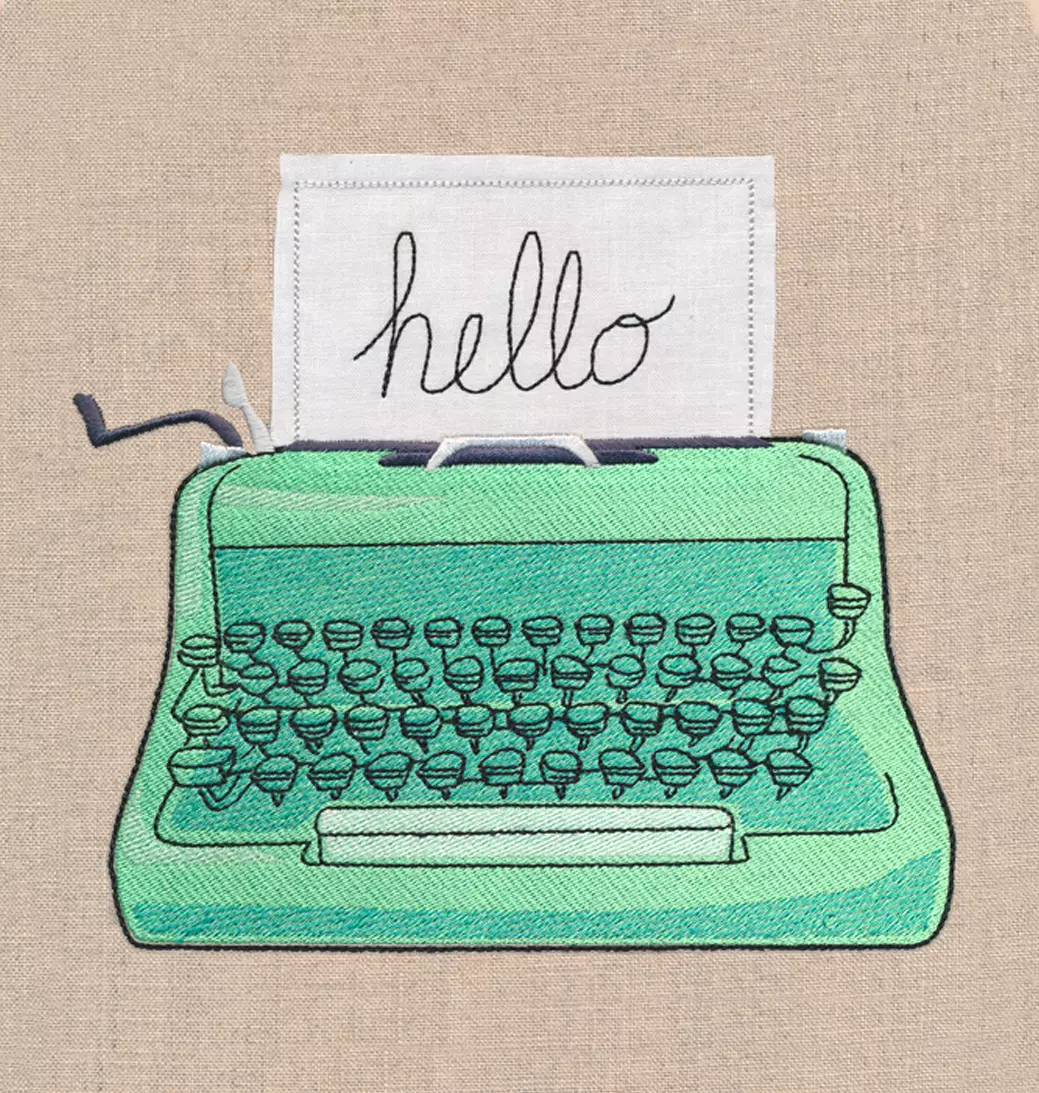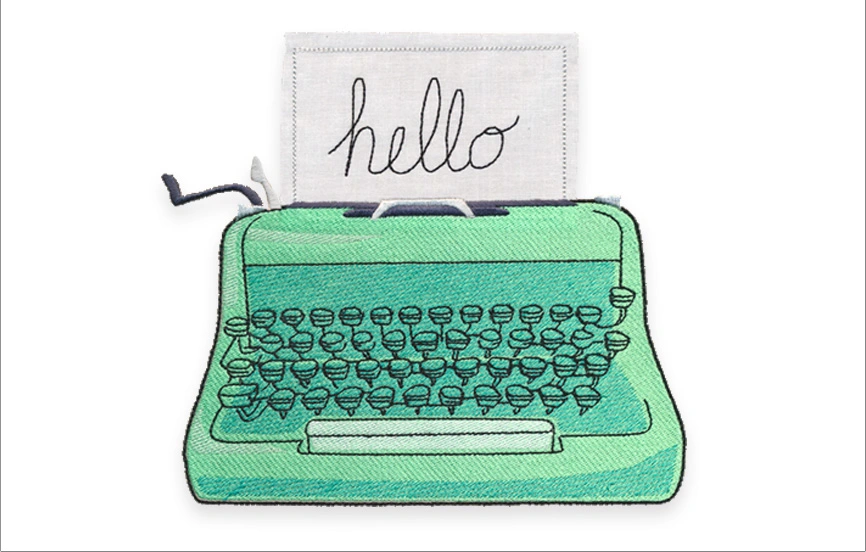Sewing and crafts can be many different things to many different people. For many years it was a happy homemaker thing, something quaint and cute and traditional. Crafting recently has taken a turn into the alternative DIY scene, and often has that punky sensibility to it. However, being a crafty person doesn’t always mean you have to be all edgy and grungy. Sometimes, it can be all about being refined in a classy, regal way. Crafting can even be a little luxurious. If that style jibes with you, then you’re going to love this tutorial on how to make your own swank luxury crafting box, with a pincushion top ripe with Napoleonic-style luxury.
Supplies
To make your luxury sewing box, you’ll need:
- A wood box (try and find one where the top has a bit of an overhang and is not flush with the rest of the box)
- High density craft foam
- Cotton batting
- Paint and paintbrush
- Craft glue
- Decorative cord, trim, or ribbon
- Some swank luxurious fabric
- An awesomely regal embroidery design
- No-show mesh stabilizer
- Staple gun
Designs Used
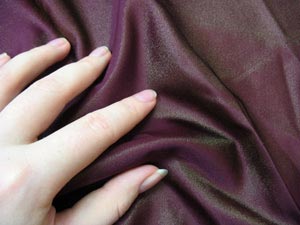
It’s best to really get the luxurious feel of this crafting box across to pick out some fun, shiny fabrics. Just be sure to test your embroidery on a bit of it first, as some fine fabrics are too delicate to get good embroidery results.
You need enough of your fabric to cover the top of your box with 1 to 2 inches extra all around.
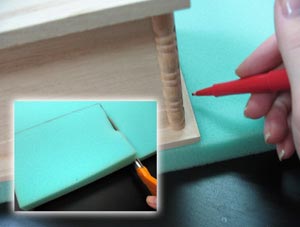
The first thing we’re going to do is prep our cushy cover so the top can function as a giant pincushion while we’re using the box. Flip your box upside down and trace the lid onto a piece of your foam. Cut it out.
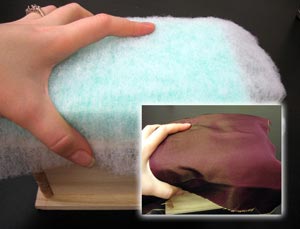
Flip your box over and place your new foam piece on the lid. If you want to soften the edges a bit, cover the foam with a piece of cotton batting. Finally, take your shiny fabric and place that on top, to get an idea of size and fit. Tug down on the edges to see if you like how everything smoothes out. You can even take a few pieces of tape and tape down 4 corners to get a good sense of what the fabric will look like all smoothed out.
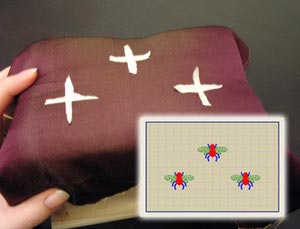
Now it’s time to mock up our embroidery. I’m using our Napoleonic bee mini. The thing about this design is that in order to really get the old style look, it’s meant to be repeated in a pattern. You don’t need to repeat it too much, just a few times to get the idea across.
There are a number of ways of setting up this embroidery. If you use software like Embird, or the kind that comes with your machine, you can copy and paste three bees in one embroidery file and the machine will sew them all out in one hooping.
Another way to do it is the way I did it, to measure and mark out where your designs will go, and just move the location of the needle after each bee is stitched out. This is especially useful when trying to line up the two bees that are supposed to be perfectly level, as you can just move the needle directly across from the last bee.
If your hoop is too small to be able to stitch out all three bees in one hooping, you’ll have to carefully re-hoop each time. All three ways work, some are just easier than others!

Oooohh, metallic... you gotta go with a little bling if you want it to look luxurious.
However you stitched out your bees, unhoop them when you’re all done stitching. I used no-show mesh stabilizer, because it will be more forgiving as part of the pincushion top, and not be too stiff.
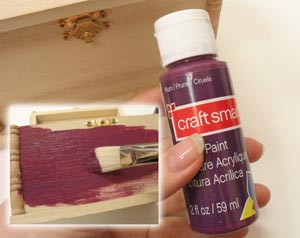
Next, let’s prep our box so it looks a little fancier than plain wood! There are lots of ways of doing this, from staining and sealing it, to simply painting it. I opted for painting.
Grab some acrylics that go with your fabric, and go to town painting your box! Just take care not to paint over the latches or hinges if you can help it. Let your box sit and dry for awhile. Acrylics don’t take long.
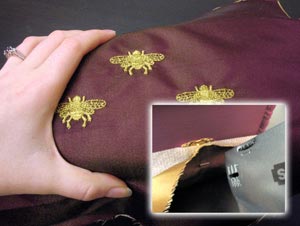
Once your box is dry, it’s time to attach our cushy top! Take your embroidered fabric and cut it down so it just fits over your lid with about two inches extra fabric all around. Lay your bees across the top and get them centered all nice.
Once you have the fabric centered on the lid, keep it in place and flip the whole thing over, so the fabric is sitting on your work surface with the box on top of it. Grab your stable gun and take the middle of one of the sides of your fabric, fold the edge over the edge of the wood box (what would be the underside of the lid) and staple it in place!
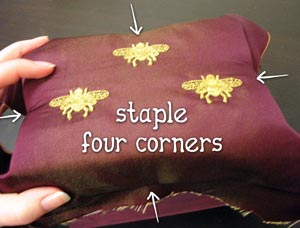
Now go to the side directly opposite and staple that middle in, pulling it tight as you do. Go to the right side of your box, staple the middle, and finally, to the left, so you have four corners tacked down, with the fabric pulled nice and snug. Try and keep the staples as close to the box as possible, they’ll be easier to hide that way.
The idea is by stapling the fabric under the edge of the box, you’ll never see them unless you look at the box from underneath.
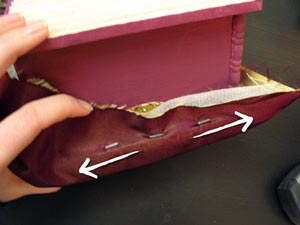
Now we’re going to repeat what we just did, stapling one side across from the other. Work your way out from the middle, stapling first to the right of your first one, and then to the left. Be sure to always staple the opposite side of your last staple so you can keep the tension even. Keep working out from the middle of each side until you get closer to the corners.
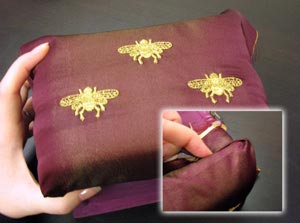
To do the corners, pull them taut and then fold the corner like you would a bed sheet, pulling one edge under another, like the picture. Staple that flap in place.
Just remember, getting the staple gun in tight to these corners is tricky, especially if you’re working with such a small box like mine. Take your time. You’ll probably have to remove and redo some staples as you go along. Remember, we will do something to mostly hide these later.
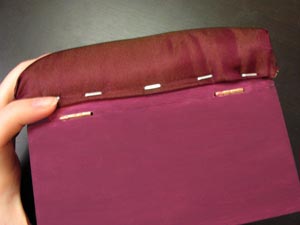
If you do happen to have an area on your box without an overhang edge, like the back of my box, don’t panic. Just fold the raw edge of everything under, about even with the rest of your folds, and staple that in place. It’ll be covered up with our cord soon.
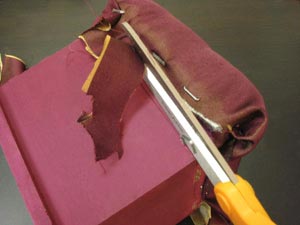
Once everything is stapled in place, trim off as much of the excess as possible, so it looks nice and clean when viewed from above. You can see in the photo here I hadn’t quite finished all my corners, but sometimes having too much fabric to work with is a hindrance, so I chopped some of it off so it wouldn’t be as bulky when I folded it.
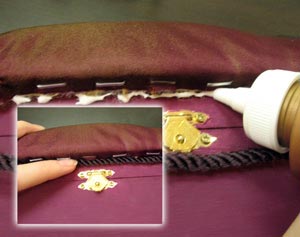
Once all your fabric has been neatly trimmed to the edge of the box, run a line of glue just underneath. Take a piece of matching cord or ribbon, and glue it in place, to hide any uneven edges and staples that came out too far.
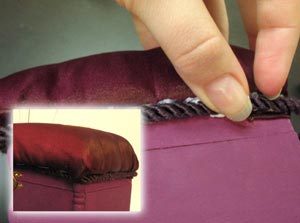
Run it all the way around your box. When you get to a place like the back, where the staples are clearly visible, just glue it right over them. Cut it to size and glue the two ends together at the back.
You can see in the little inset photo it really helps tidy up the edges and hide some imperfections with your stapling (not that you messed up like I did ... I’m sure yours looks beautiful).

Finished!
You have a wonderfully luxurious little crafting box that shows your regal style. Deep colors, shimmery fabrics, and gold thread mixed with old Napoleonic designs make for truly classy old-world charm.
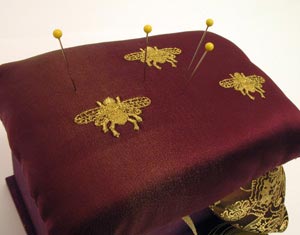
Best of all, not only is your new box classy, but the top works beautifully as a large pincushion, great for holding needles and pins while you’re working on all your crafty projects ... and to think, this started as a cheap balsa wood box fro your craft store! Shh ... it’s our little secret.

